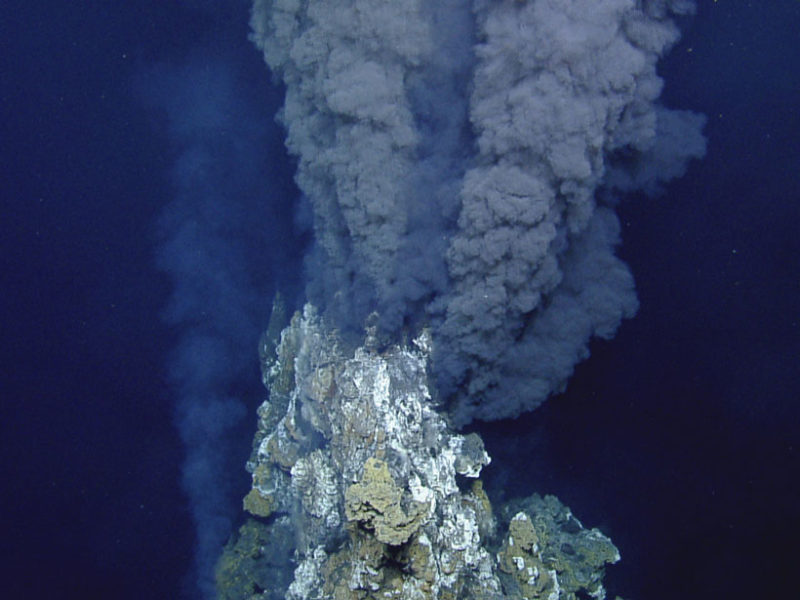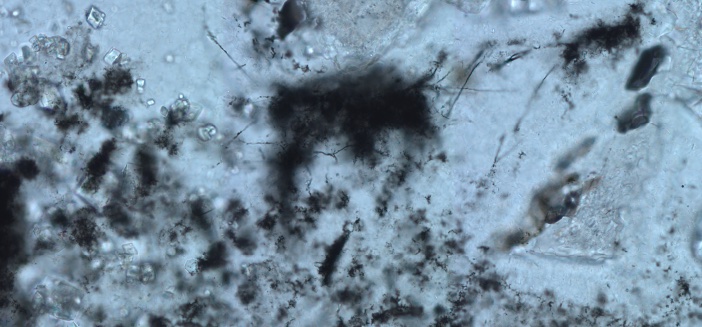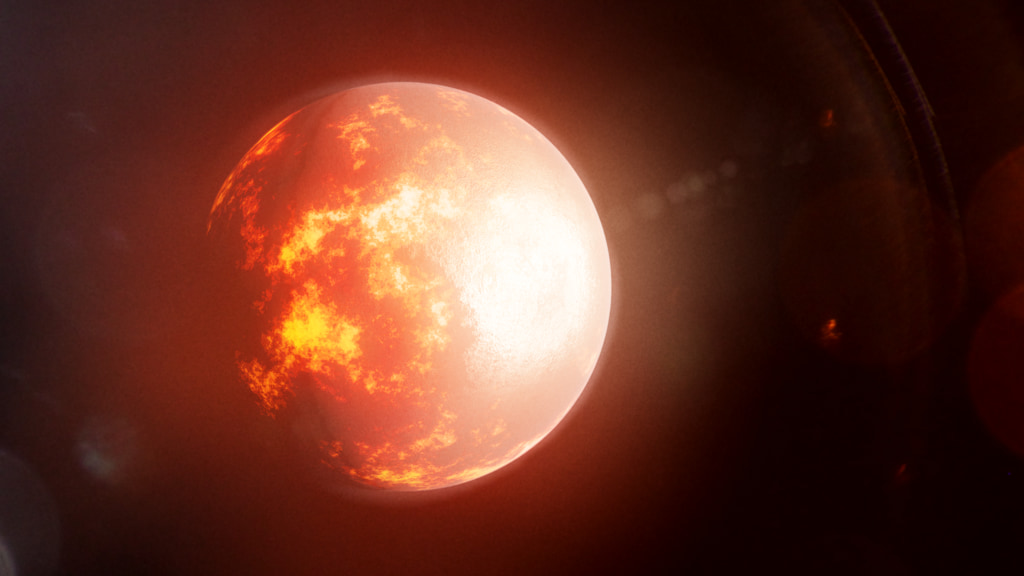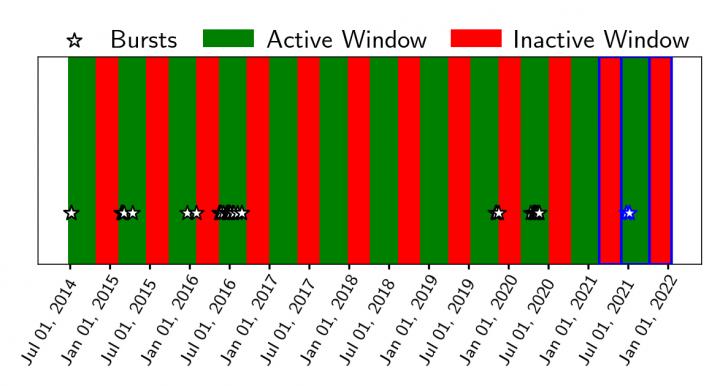The fossilized remains of methane-cycling microbes have been found in exposed sedimentary seafloor rocks in South Africa. These microbes, dating back 3.42 billion years, could extend the fossil record back to when life first began on Earth. Plus, teenage exoplanets orbit sibling stars, and gamma-ray bursts happen on schedule.
Podcast
Transcript
Hello and welcome to the Daily Space. I am your host Dr. Pamela Gay.
And I am your host Beth Johnson.
And we are here to put science in your brain.
Any of you who have been watching for a while know that we like hydrothermal vents. They make it possible for sea life to exist without sunlight, they add all sorts of nutrients to seawater, they add material to the ocean floor that records flips in the Earth’s magnetic field, and they do a lot of good things while just looking cool. Now we are learning that they are spouting ancient dissolved organic carbon into the ocean.

In general, the organic carbon in the ocean comes from organisms doing photosynthesis at the ocean surface. Some of that carbon – Carbon-14 – is radioactive and over time will decay, and the ratio of the resulting elements allows the age of the material to be determined.
In looking at the ratios of carbon in seawater from a variety of sites, researchers led by Ellen Druffel discovered that the water near hydrothermal vents appears to be ancient, implying that dissolved organics from the deep past are somehow released in or near hydrothermal vents. It’s unclear if the vents themselves are responsible, or if microbes at the vents eat dissolved inorganic carbon and process it into dissolved organic carbon that is old in nature. More research is needed, and it’s awesome that these vents have more mysteries for us to explore.
While we have the ability to see across the vastness of space, our own oceans only like to reveal a few meters to tens of meters of their contents of time. This can make exploration tricky. Even the surface of the ocean can be fickle in letting us understand what’s going on. Satellites can’t see beneath clouds, and the surface temperatures of waters beneath storms can often decide the outcome of the storms in those clouds.
Since we can’t cake the ocean with sensors, scientists have instead developed a remote control ocean drone, powered by solar power, that can navigate to places of interest. In a new paper in Geophysical Research Letters, a team led by Samantha Wills sent ten uncrewed sailing vehicles into the pools of cool air beneath thunderstorms.

As it rains, water will evaporate, and this process pulls energy from the air and makes the temperatures drop. The cold air sinks, creating a downdraft that then hits the warm ocean surface where it is heated and begins to rise. Common in the tropics, these convection cells aren’t well understood, but these new drones, in just six months, were able to sail 137,000 kilometers and measure 300 cold pools. The data from these events demonstrated how wind builds, air and water temperatures change, and more. Future analysis should improve weather models. I can’t wait for the day when we can combine satellite images and drone data regularly in the nightly weather reports.
As a reminder, the reason for the seasons is the tilt of the planet. As our world goes from having the north pole pointed toward the Sun to having the south pole tilted more toward the Sun, we see the temperatures and weather in Earth’s hemispheres vary back and forth. This causes animals to migrate and hibernate, and it creates growing seasons. In many ways, the complexity of our planet is driven by the desire for life to spread and multiply, and the need for that life to adapt to the environments it is spreading into.
In a presentation at the Goldschmidt Conference, researchers lead by Stephanie Olson postulate that planets with a tilt like Earth’s will develop more complex life than planets that are upright and never experience seasons.

According to Olson: There are several factors to consider in looking for life on another planet. The planet needs to be [at] the right distance from its star to allow liquid water and have the chemical ingredients for the origin of life. But not all oceans will be great hosts for life as we know it, and an even smaller subset will have suitable habitats for life to progress towards animal-grade complexity. Small tilts or extreme seasonality on planets with Uranus-like tilts may limit the proliferation of life, but [a] modest tilt of a planet on its axis may increase the likelihood that it develops oxygenated atmospheres that could serve as beacons of microbial life and fuel the metabolisms of large organisms. The bottom line is that worlds that are modestly tilted on their axes may be more likely to evolve complex life. This helps us narrow the search for complex, perhaps even intelligent life in the Universe.
While we can’t yet determine if distant exoplanets are tilted, this research definitely adds an interesting dimension to the way we think about life.
There are days when we get new research results about our Earth that are all the more exciting because of what they say could be possible on other worlds. In a new paper appearing in Science Advances, researchers led by Barbara Cavalazzi document the discovery of microfossils: the imprints of early microbes called methanogens that once dominated our world.

These microbes existed 3.42 billion years ago, during a time when Mars had oceans and Venus wasn’t all that different from Earth. Life was able to form just that fast, and this life not only pushes back the when of life but also pushes out the acceptable conditions for life.
These fossils were found in two layers of sedimentary rock collected in South Africa near the border of Eswatini and Mozambique. According to Cavalazzi: We found exceptionally well-preserved evidence of fossilized microbes that appear to have flourished along the walls of cavities created by warm water from hydrothermal systems a few meters below the seafloor. Sub-surface habitats, heated by volcanic activity, are likely to have hosted some of Earth’s earliest microbial ecosystems and this is the oldest example that we have found to date.
There are three basic things required for life: a solvent like water, a thermal gradient to drive chemical reactions, and nutrients to use in those chemical processes. In these early times, cooler seawater interacted with fluids from hydrothermal vents, creating a complex chemical soup in which these microbes thrived. It is unknown where or how life started on earth, but hydrothermal vents are considered one potential location. And Cavalazzi goes on to point out: As we also find similar environments on Mars, the study also has implications for astrobiology and the chances of finding life beyond Earth.
At this time, we haven’t identified the signs of past hydrothermal activity in the areas explored by the Curiosity and Perseverance rovers, but we do see sedimentary rock. It is unclear if either mission has the capacity to discover these kinds of fossils: their tools are generally destructive and tear samples apart to look at them chemically instead of photographically. But if there happens to be a piece of sedimentary rock that has flaked off just right then maybe? This is probably not going to happen, but it is amazing to know that someday, with better tools, there will be folks like Cavalazzi fossil hunting on Mars.
At first glance, this next story was interesting because more exoplanets were found, but we’ve been announcing new exoplanets almost steadily for the last decade-plus. Digging a little deeper, this story involves a new paper published in The Astronomical Journal about four new exoplanets that were found orbiting a pair of stars. These stars are related, the planets are teenagers, and they are all giving us more information about a stage of planetary formation we don’t yet understand.

I know. I say all the time that we’re never going to completely understand planetary formation. But with every story that comes out with new information, I’m beginning to think I will be proven wrong. And that’s wonderful.
What makes these stars and their planets so special? According to lead author Christina Hedges: The planets in both systems are in a transitional, or teenage, phase of their life cycle. They’re not newborns, but they’re also not settled down. Learning more about planets in this teen stage will ultimately help us understand older planets in other systems.
The two stars are TOI 2076 and TOI 1807, they are K-type stars or dwarf stars oranger than the Sun, they are 130 light-years away and 30 light-years apart from each other. They are relatively young stars as well, only about 200 million years old. By comparison, that is less than 5% the age of the Sun. And thanks to data from the amazing Gaia satellite, we know they are moving in the same direction, which is how we know they’re related.
As for the planets, TOI 2076 has three mini-Neptunes with the innermost orbiting every ten days. The outer two, per the press release, have “orbits exceeding 17 days”. TOI 1807 has one planet, about twice the size of Earth, and orbiting in 13 hours. So these are incredibly close to their stars. Both stars likely experience flares that give off far more energy than the ones our Sun produces, and they likely produce those flares frequently, so neither system sounds very good for life.
But life isn’t the purpose of studying this system. Again, these planets seem to be at a point in their evolution that is between the point where they have thick atmospheres post-formation and the point where they lose those atmospheres due to stellar radiation. We’ve covered a few studies that indicate that this type of planetary evolution could be how we get some rocky worlds. Now we have four planets in between the two potential stages that we can possibly study further.
First, though, the team needs to determine the masses of the four exoplanets. That would lead to the possibility of Hubble or another space telescope being able to observe the atmospheres. Then the team could use that data to analyze the size and composition and figure out where in the evolutionary process the exoplanets are.
Co-author Trevor David sums up the work: Many objects we study in astronomy evolve on such long timescales that a human being can’t see changes month to month or year to year. If you want to see how planets evolve, your best bet is to find many planets of different ages and then ask how they’re different. The TESS discovery of the TOI 2076 and TOI 1807 systems advances our understanding of the teenage exoplanet stage.
Astronomy is a long game. Here’s hoping this team gets the data they need to complete this analysis. More planetary formation updates, please!
Astronomy is a long game, and sometimes, keeping our eyes on things across decades allows weird new phenomena to be discovered. The star SGR1935+2154 is a neutron star that periodically gives off gamma-ray radiation. It is thought this star has a powerful magnetic field, and that magnetic field periodically does something we can’t describe, and that something gives off gamma rays. Most of the time, these events are just enough to get the star noticed, but periodically, the events are briefly very powerful in radio light. This makes SG1935+2154 the only known fast radio burst source in our Milky Way galaxy.

Regularly observed since 2014, it was initially noticed that this object can flicker with bursts of soft gamma rays, sometimes one right after another and sometimes with long quiet periods. While random flickering can have a pattern, it was noticed over the years that this object would flicker away for about four months and then go silent for three months. This is like turning chaotically blinking Christmas lights off and on over the seasons.
This kind of windowing behavior is not something we’re used to seeing in astronomy. It’s not like stars hibernate or anything. The question has to be asked: is this real or just random chance?
On March 19, the team put out a pre-print that predicted that SGR1935+2154 would be quiet until June when it would start flickering again, and on June 24 the first of what have been many flickers have been observed. According to researcher Bruce Gossan: These new bursts within this window means that our prediction is dead-on. Probably more important is that no bursts were detected between the windows since we first published our preprint.”
Since 2014, they have observed ten windowed periods of activity. Statistically, there is only a three in 10,000 chance that this occurred randomly.
Why are these occurring? We don’t know, and that is awesome; we have one more amazing mystery to track down. According to the release on this story: Grossan and Linder can only guess. Soft gamma-ray bursts from magnetars are thought to involve starquakes, perhaps triggered by interactions between the neutron star’s crust and its intense magnetic field. Magnetars rotate once every few seconds, and if the rotation is accompanied by a precession — a wobble in the rotation — that might make the source of burst emission point to Earth only within a certain window. Another possibility, Grossan said, is that a dense, rotating cloud of obscuring material surrounds the magnetar but has a hole that only periodically allows bursts to come out and reach Earth.
When we figure out what’s going on, we’ll bring it to you here. Until then, this has been the Daily Space.
Learn More
Carbon Dating the Ocean: Vents Add Old Carbon
- Hydrothermal Vents May Add Ancient Carbon to Ocean Waters (Eos)
- “Dissolved Organic Radiocarbon in the Eastern Pacific and Southern Oceans,” Ellen R. M. Druffel et al., 2021 May 24, Geophysical Research Letters
Self-Driving Sailing Ships Do Science
- Remote-Controlled Ocean Drones Observe Atmospheric Cold Pools (Eos)
- “Cold Pools Observed by Uncrewed Surface Vehicles in the Central and Eastern Tropical Pacific,” Samantha M. Wills, Meghan F. Cronin, and Dongxiao Zhang, 2021 May 11, Geophysical Research Letters
Tilted Planet Points Toward Complex Life?
Life Dated Back to 3.42 Billion Years Ago
- Europlanet Society press release
- “Cellular remains in a ~3.42-billion-year-old subseafloor hydrothermal environment,” Barbara Cavalazzi et al., 2021 July 14, ScienceAdvances
Sibling Stars Found with Teenage Exoplanets
- NASA press release
- “TOI-2076 and TOI-1807: Two Young, Comoving Planetary Systems within 50 pc Identified by TESS that are Ideal Candidates for Further Follow Up,” Christina Hedges et al., 2021 July 12, The Astronomical Journal
Soft Gamma Rays Flicker Chaotically in Time Windows
- Galactic gamma ray bursts predicted last year show up right on schedule (EurekAlert)
- “Distinguishing time clustering of astrophysical bursts,” Mikhail Denissenya, Bruce Grossan, and Eric V. Linder, 2021 July 6, Physical Review D
Credits
Written by Pamela Gay and Beth Johnson
Hosted by Pamela Gay and Beth Johnson
Audio and Video Editing by Ally Pelphrey
Content Editing by Beth Johnson
Intro and Outro music by Kevin MacLeod, https://incompetech.com/music/


 We record most shows live, on Twitch. Follow us today to get alerts when we go live.
We record most shows live, on Twitch. Follow us today to get alerts when we go live.